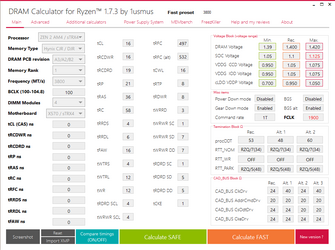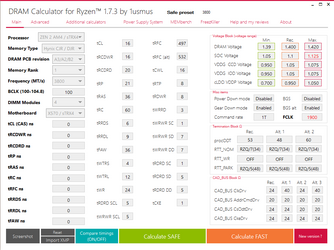Please read this post entirely before responding please...
I got the system into windows with the slow timings sheet above, but my mouse would stutter/freeze, for an instant, every 5 or so seconds. I did try the fast timings first, but I had to reset cmos.
So I think the system is capable, I just need to reset my approach and see what happen
I'm running into two annoyances..
1. My MSI Unify BIOS basically has two separate OCn sections. There's the main OC window that's reached via the main page and then there's AMDs overclocking section. I can't remember which atm, but one seems to take the values dram calc displays while the other does a mix of all the weird input values. Example.. rather than just a number it'll have the ohms values and whatnot.
2. My BIOS has basically 4 tRFC input fields. tRFC, tRFC1, tRFC2, tRFC4. Not sure how I'm suppose to input values into this when the dram calculator only provides one number... Though I see on the "additional calculators" page of dram calculator, it has a tRFC calc.. do I use this?
All I've done so far is... Manually plug in "slow" timings above. I kept dividers at 1.1.1 and dram voltage at 1.4v. booted into windows. Mouse stutters. I haven't bench marked or stressed it yet.
After this I ran out of time and reset my default XMP data, so I could enjoy some games.
Woomack thanks for the info.
One question so far...
1. I'm scrapping my progress and will restart with your recommendations.. I'm going to try your recommended 16-19-19 @ 1.4-1.5... but do I just...
OK I know I need to adjust the following...
Adjust dram voltage to 1.4v, enter primaries as 16-19-19-39, manually enter 1900 FCLK and 1900 uCLK. Adjust/Leave the SoC, VDDP, VDDG voltages at the values XMP uses?
BUT do I load XMP first or leave XMP out of this?
I'm looking for the two different BIOS pages in the manual so I can show you guys the AMD OC menu vs the MSI OC menu. When you change values in one section it does change them in the other... As for memory timings, I think I need to stay away from the section that actually shows/adjusts the timings in NS... and this would be the AMD section..
OK.. from what I understand... There's the OC page thats MSIs OCn menu... then there's the AMD Overclocking menu(under settings > advanced) and this is a part of AMDs AGESA code? Which to use? MSI's OC page is easier to adjust DRAM timings but AGESA is easier to SoC, VDDP, VDDG, adjustments. I guess I could use both. Use one for each different thing and don't mixed identical settings.

